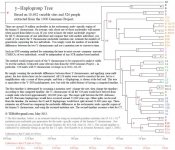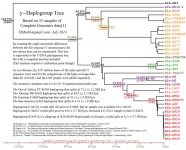bicicleur 2
Regular Member
- Messages
- 6,367
- Reaction score
- 1,402
- Points
- 113
Knordtvedt has calculated the age of some mutations in haplogroup I
http://knordtvedt.home.bresnan.net/
I don't know his exact methods but I suspect he combines STR- and SNP-analyses
He estimates a new generation every 30 years
Data from the 1000 genomes project became available last year.
It allows to construct a full y-DNA tree and count all SNP's.
Here are 2 trees constructed like that :


This is the source :
http://www.goggo.com/terry/HaplogroupI1/
The tree is subject to the chosen samples.
Assumed mutation rate 3.0 x 10 -8.
The ages for haplo I1 come out older than the estimate from Knordtvedt.
Anyway, mutation rate has to be estimated, and also how long every generation switch lasts (this is largely influenced by the culture and habits of the tribe).
It looks like accurate TRMCA estimates are not possible for the moment.
http://knordtvedt.home.bresnan.net/
I don't know his exact methods but I suspect he combines STR- and SNP-analyses
He estimates a new generation every 30 years
Data from the 1000 genomes project became available last year.
It allows to construct a full y-DNA tree and count all SNP's.
Here are 2 trees constructed like that :


This is the source :
http://www.goggo.com/terry/HaplogroupI1/
The tree is subject to the chosen samples.
Assumed mutation rate 3.0 x 10 -8.
The ages for haplo I1 come out older than the estimate from Knordtvedt.
Anyway, mutation rate has to be estimated, and also how long every generation switch lasts (this is largely influenced by the culture and habits of the tribe).
It looks like accurate TRMCA estimates are not possible for the moment.

